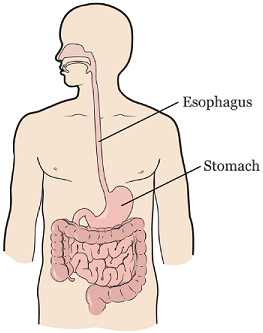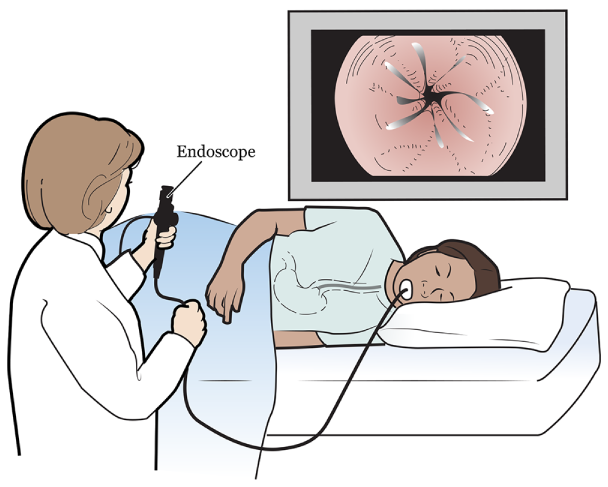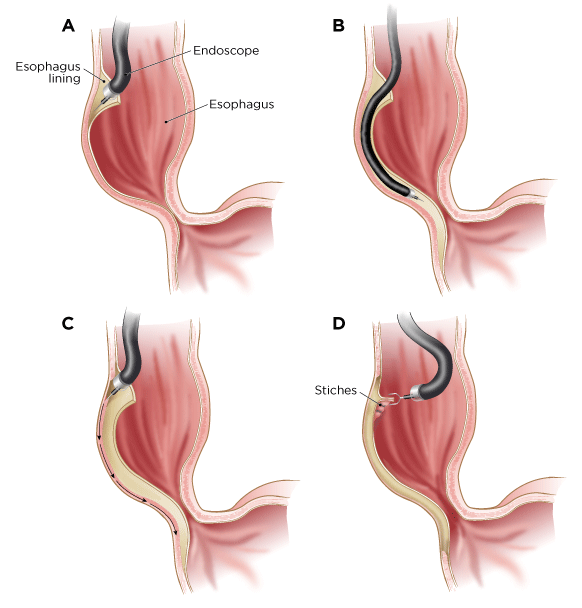
This information will help you get ready for your per oral endoscopic myotomy (POEM) procedure at MSK. It also explains how to care for yourself after your procedure.
POEM is a procedure to treat swallowing disorders without surgery. A swallowing disorder is when you have trouble swallowing. It’s also when the muscles you use to swallow are too tight.
During your procedure, your healthcare provider will use a flexible tube called an endoscope to look inside your esophagus (ee-SAH-fuh-gus). Your esophagus is the tube that carries food and liquid from your mouth to your stomach (see Figure 1).
Your healthcare provider will loosen the muscles in your esophagus that are causing the swallowing problem. They will do this by attaching tools to the end of the endoscope to separate the muscles. This will help you swallow more easily by letting your esophagus move food and liquid into your stomach.
Your healthcare provider will talk with you about what to expect and how to get ready. You will stay in the hospital for 2 to 3 days after your procedure.
There is a chance your healthcare provider cannot do the POEM procedure. Your esophagus may be too narrow for the endoscope to fit into it. If this happens, your healthcare provider will explain why they cannot do the procedure. They will talk with you about other treatment options. After talking with your healthcare provider, you can go home with your care partner.
2 weeks before your procedure
Ask about your medicines
You may need to stop taking some of your usual medicines before your procedure. Talk with your healthcare provider about which medicines are safe for you to stop taking.
We’ve included some common examples below, but there are others. Make sure your care team knows all the prescription and over-the-counter medicines you take. A prescription medicine is one you can only get with a prescription from a healthcare provider. An over-the-counter medicine is one you can buy without a prescription.
It is very important to take your medicines the right way in the days leading up to your procedure. If you don’t, we may need to reschedule your procedure.
Blood thinners
You may be taking a blood thinner. This is medicine that affects the way your blood clots. If so, ask the healthcare provider who prescribes it if you should stop taking it. They will recommend that you stop taking the medicine based on the reason you’re taking it.
We’ve listed some examples of common blood thinners below. There are others, so be sure your care team knows all the medicines you take. Do not stop taking your blood thinner without talking with a member of your care team.
|
|
Medicines for diabetes
If you take insulin or other medicines for diabetes, you may need to change the dose. Ask the doctor who prescribes your diabetes medicine what to do the day before and the morning of your procedure.
Do not take these medicines the day before or the day of your procedure:
- Metformin, such as Glucophage® or Glumetza®.
- Medicine that contains metformin, such as Janumet®.
Get a letter from your healthcare provider, if needed
A clearance letter is a letter saying you can safely have a procedure. You need one if you:
- Have an automatic implantable cardioverter-defibrillator (AICD).
- Had chest pain, dizziness, or trouble breathing that’s new or worse, or have fainted in the last 6 weeks.
You can get a clearance letter from your cardiologist (heart doctor). If you do not have a cardiologist, you can get one from your primary care doctor.
Your MSK doctor’s office must have your clearance letter at least 3 days before your procedure.
1 week before your procedure
Follow your healthcare provider’s instructions for taking aspirin
Aspirin can cause bleeding. If you take aspirin or a medicine that has aspirin, you may need to change your dose or stop taking it 7 days before your procedure. Follow your healthcare provider’s instructions. Do not stop taking aspirin unless they tell you to.
To learn more, read How To Check if a Medicine or Supplement Has Aspirin, Other NSAIDs, Vitamin E, or Fish Oil.
Arrange for someone to take you home
You must have a responsible care partner take you home after your procedure. A responsible care partner is someone who can help you get home safely. They should be able to contact your care team if they have any concerns. Make sure to plan this before the day of your procedure.
If you don’t have a responsible care partner to take you home, call one of the agencies below. They’ll send someone to go home with you. There’s a charge for this service, and you’ll need to provide transportation. It’s OK to use a taxi or car service, but you still need a responsible care partner with you.
| Agencies in New York | Agencies in New Jersey |
| VNS Health: 888-735-8913 | Caring People: 877-227-4649 |
| Caring People: 877-227-4649 |
3 days before your procedure
Talk with your endoscopy nurse
An endoscopy nurse will call you between and 3 days before your procedure. They will go over the instructions in this guide with you. They will also ask you questions about your medical history.
The nurse will also go over your medications and tell you which medications to take the morning of your procedure.
2 days before your procedure
Iron supplements
If you take an iron supplement, stop taking it 2 days before your procedure. Iron supplements can change the color of your esophagus. This can make it harder for your healthcare provider to see it clearly.
The day before your procedure
Follow a full liquid diet
Start following a full liquid diet the day before your procedure. A full liquid diet is a diet where you do not eat any solid foods. You can eat foods that you do not need to chew or bite, such as yogurt. Some examples of things you can drink and eat are listed in the “Full Liquid Diet” table.
While you’re on this diet, try to drink at least 1 (8-ounce) cup of liquid every hour while you’re awake. Drink plenty of different kinds of liquids, not just water, coffee, and tea. You can drink liquids of any color.
If you have diabetes, ask the healthcare provider who manages your diabetes what you should do while on a full liquid diet.
| Full Liquid Diet | ||
|---|---|---|
| OK to Drink | Do Not Drink | |
| Soups |
|
|
| Dairy |
|
|
| Grains |
|
|
| Nutritional Supplements* |
|
|
| Other |
|
|
* You can buy nutritional supplements at your local pharmacy without a prescription.
Note the time of your procedure
A staff member from the Admitting Office will call you after noon (12 p.m.) the day before your procedure. If your procedure is scheduled for a Monday, they will call you on the Friday before.
The staff member will tell you what time to arrive at the hospital for your procedure. They will also remind you where to go. If you do not get a call by , call 212-639-7606.
If you need to cancel your procedure, call the GI scheduling office at 212-639-5020.
The day of your procedure
Instructions for drinking
Between midnight (12 a.m.) and 2 hours before your arrival time, only drink the liquids on the list below. Do not eat or drink anything else. Stop drinking 2 hours before your arrival time.
- Water.
- Clear apple juice, clear grape juice, or clear cranberry juice.
- Gatorade or Powerade.
-
Black coffee or plain tea. It’s OK to add sugar. Do not add anything else.
- Do not add any amount of any type of milk or creamer. This includes plant-based milks and creamers.
- Do not add honey.
- Do not add flavored syrup.
If you have diabetes, pay attention to the amount of sugar in your drinks. It will be easier to control your blood sugar levels if you include sugar-free, low-sugar, or no added sugar versions of these drinks.
It’s helpful to stay hydrated before surgery, so drink if you are thirsty. Do not drink more than you need. You will get intravenous (IV) fluids during your surgery.
Stop drinking 2 hours before your arrival time. This includes water.
Your healthcare provider may have given you different instructions for when to stop drinking. If so, follow their instructions.
Things to remember
- Take only the medicines your healthcare provider told you to take the morning of your procedure. Take them with a few sips of water.
- Do not put on any lotion, cream, powder, makeup, perfume, or cologne.
- Remove any jewelry, including body piercings.
- Leave valuable objects (such as credit cards and jewelry) at home.
- If you wear contact lenses, wear your glasses instead.
What to bring
- A list of the medicines you take at home, including patches and creams.
- Your rescue inhaler, such as albuterol (Ventolin®) for asthma, if you have one.
- A case for your glasses or contacts, if you wear them.
- Your Health Care Proxy form and other advance directives, if you filled them out.
- If you have an implanted pacemaker or AICD, bring your wallet card with you.
Where to go
Your procedure will take place at the:
Endoscopy Suite at Memorial Hospital (MSK’s main hospital)
1275 York Ave. (between East 67th and East 68th streets)
New York, NY 10065
Take the B elevator to the 2nd floor. Turn right and enter the Surgery and Procedural Center through the glass doors.
Visit www.msk.org/parking for information about parking at this location.
What to expect
Once you arrive, many staff members will ask you to say and spell your name and date of birth. This is for your safety. People with the same or similar names may be having procedures on the same day.
After changing into a hospital gown, you will meet your nurse. They will place an intravenous (IV) line into one of your veins, often in your hand or arm. Your care team will use your IV to give you anesthesia (medicine to make you sleep) during your procedure. You may also get fluids through your IV before your procedure.
You will talk with your doctor before your procedure. They will explain the procedure and answer your questions.
During your procedure
When it’s time for your procedure, a staff member will bring you into the procedure room. A member of your care team will help you onto the exam table. Your nurse will keep track of your heart, breathing, and blood pressure. You will get oxygen through a thin tube that rests below your nose.
You will get anesthesia through your IV, which will make you fall asleep. Once you’re asleep, your doctor will place the endoscope into your mouth and down your esophagus.
There is a small camera attached to the end of the endoscope. Your doctor will use this camera to guide where the endoscope goes. They will see video from the camera on a TV monitor next to them (see Figure 2).

During your procedure, your doctor will make an incision (surgical cut) in the inner layer of your esophagus (see Figure 3, A). Then, they will use the endoscope to tunnel into the lining of your esophagus muscles to make a pathway (see Figure 3, B). They will attach a special tool into the end of the endoscope. Using the tool, they will cut and loosen any tight muscles in your esophagus (see Figure 3, C).
Once your procedure is done, your doctor will remove the endoscope. They will close your incisions with staples or sutures (stitches) (see Figure 3, D).
This procedure most often takes 1 to 3 hours. Sometimes it can take longer. Ask your care team how long they expect your procedure to take.

After your procedure
In the hospital
When you wake up after your procedure, you will be in the Post-Anesthesia Care Unit (PACU). A nurse will keep track of your body temperature, pulse, blood pressure, and oxygen levels. You will get oxygen through a thin tube that rests below your nose.
You will stay in the hospital for 2 to 3 nights. While you’re in the hospital, you will have an esophagram (ee-SAH-fuh-gram). This is an X-ray scan that takes pictures of the inside of your esophagus. It’s done to make sure your esophagus is healing.
At home
Your healthcare provider will teach you how to care of yourself before you leave the hospital. They will talk with you about what diet you should follow and how long to follow it.
For the first 7 days after your procedure:
- Do not drink alcohol.
- Do not do any high-energy exercise (such as jogging).
- Do not lift anything heavier than 10 pounds (4.5 kilograms).
- Try to stay around New York, if possible. This is in case you have any issues after your procedure.
Going back to work
Most people can go back to work 7 days after having this procedure. If your job involves lots of movement or heavy lifting, you may need to stay out a little longer. Ask your healthcare provider when it will be safe for you to start working again.
Follow-up care
You will have a follow-up visit with your healthcare provider 3 months after your procedure. At this appointment, you will have another esophagram to check how you’re healing.
When to call your healthcare provider
Call your healthcare provider if you have any of the following:
- A fever of 101 °F (38.3 °C) or higher.
- Chest pain.
- Trouble breathing.
- Weakness or feeling like you’re going to faint (pass out).
- Swelling in your esophagus or trouble swallowing.
- Throat pain that will not go away.
- Swelling in your abdomen (belly).
- Dark-colored bowel movements (poop).
- Coughing up blood.